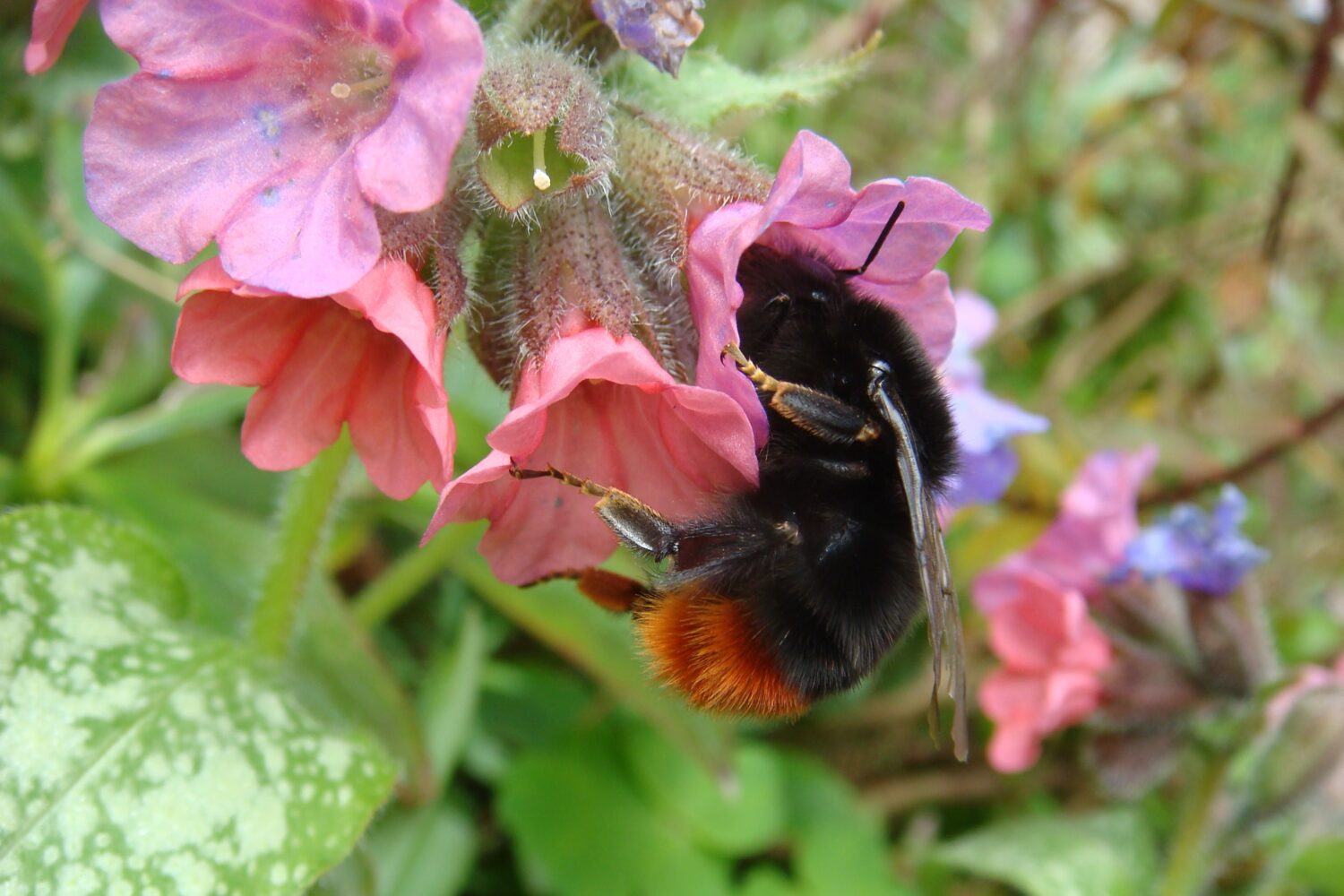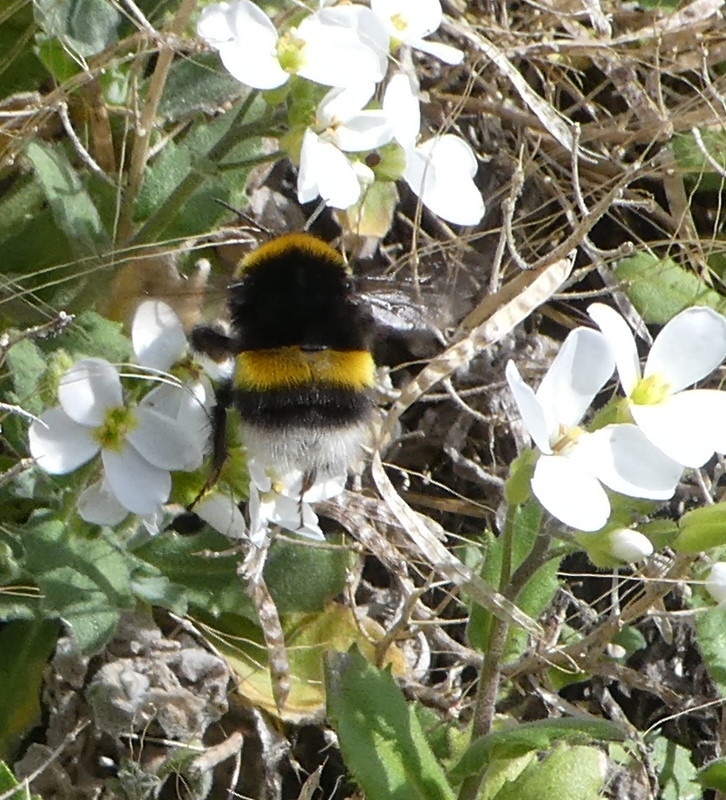At the height of spring, queen bumblebees are out in force. Local naturalist, Charlotte Rankin, guides you through seven queen bumblebees you are likely to encounter this spring.
Queen Bumblebees are harbingers of spring and are the first bees to be observed in the year. Throughout spring, queen bumblebees can be observed nest-searching. This is characterised by a zig-zagging flight low over the ground. Queen Bumblebees also make the most of early-flowering wildflowers such as Willow. Check out a queen bee with lots of pollen on her back. That means she has found a place to nest. There are 19 species of bumblebees that live in the North East. Of those, seven are most likely to be seen. This short post guides you through these species.
The giant queen bumble bee, scientifically known as Bombus dahlbomii, is truly a sight to behold. With mature queens growing up to 40 mm (1.6 inches) long, this is one of the largest bee species on Earth. Their furry, plump bodies and buzzing wings have earned them nicknames like “flying mice” and “monstrous fluffy ginger beasts.” While they may look intimidating, these giants play a crucial role in their native habitats.
Description
The giant queen bumble bee lives up to its name in terms of size. The queens have heavy, furry bodies that can reach 40 mm in length. Their thoraxes are covered in long bright ginger and orange hairs. Their abdomens are a slightly lighter orange shade. Like other bumble bees, their abdomens end in a rounded tip.
Their heads wings, and legs are solid black providing stark contrast against the vibrant orange fur. They have relatively short antennae compared to other bees. The queens’ large size, up to 1.5 grams, gives them a lumbering, buzzing flight pattern akin to a small flying mammal.
Native Habitat
The giant queen bumble bee is endemic to the temperate forests of southern South America. Their range extends from central Chile down to the southern tip of the continent in chilly Patagonia. They thrive in forests with both contiguous and fragmented distributions of flowering plants.
Compared to other bumble bees, the giant queen has a relatively confined habitat range Attempts to substantiate sightings outside of Chile and Argentina have failed. Within their native forests, they play an outsized role in pollination and ecosystem health
Role as Super Pollinators
The large size of the giant queen bumble bee makes them extremely efficient pollinators. Their furry bodies readily pick up and distribute pollen as they fly from flower to flower. Research shows they are better pollinators than honey bees, other bumble bee species, and insects in different families.
Some plants, like the Chilean lapageria rose, rely almost exclusively on the giant queen for pollination. As such, the bumble bees are crucial to maintaining genetic diversity and reproduction in these plant populations. The giant queens travel widely, allowing them to pollinate disparate flowers.
Colony Behavior
Giant queen bumble bees live in small colonies averaging 100-200 individuals. Each colony is founded by a single queen in the spring. The queen selects an underground burrow or cavity, usually an abandoned rodent den. She constructs wax honey pots and brooding chambers out of wax and gathers the first batch of pollen and nectar.
After laying her initial eggs in the chambers, the queen incubates the brood while continuing to forage. The first generation of workers hatches within a couple of months. These daughters take over foraging duties while the queen focuses on egg-laying. Reproductive males and new queens are the last to hatch before winter die-off.
Conservation Concerns
Though vital pollinators, giant queen bumble bee populations have declined precipitously. Habitat loss and the introduction of European bumble bees have brought the giant queen to endangered status. Protecting these majestic fuzzballs will require habitat restoration and controls on importing non-native species. If their populations recover, the giant queens will continue providing invaluable pollination services.
The giant queen bumble bee’s large size and critical ecological role make it a true monarch of the forest. These furry giants buzz through the understory, ensuring the health of plants that depend on them for survival. With focused conservation efforts, these bumble bee queens will continue their quiet reign long into the future.
Early Bumblebee Bombus pratorum
The Early Bumblebee is a small species of bumblebee. Nests are underground and contain no more than 100 workers. As the name suggests, queens are out early in the year. Making the end of a nest, males are also produced earlier than other bumblebee species. This can be as early as late April in the south.
Queens are noticeably smaller than other queen bumblebees. Queens have a small orange-red or rosy tail. The small extent of the tail means it can be harder to see. There are also two lemon yellow bands: one behind the head and one on the abdomen.

Red-tailed Bumblebee Bombus lapidarius
The Red-tailed Bumblebee nests underground. The nests are large, often containing over 300 worker bumblebees. This was one of the first bumblebee species to be recorded in the North East. The first record comes from the notebook of Albany Hancock dated 1827.
Queens are very distinctive with a black-haired body and a large crimson-red tail. The coat also has a velvety appearance. Queens do not have any yellow bands.

Clever Queen Bumble Bees | Life In The Undergrowth | BBC Earth
FAQ
What is the largest bumblebee queen?
What are the giant bumble bees?
How do you tell if a bumblebee is a queen?
Can giant bumble bees sting?
How long can a queen bumble bee live?
In comparison with honey bee queens with a potential life span lasting several years, the queen bumble bee can live for up to 12 months (including overwintering time), yet it’s still longer than the shorter lives of her worker and male offspring.
Is the world’s largest bumblebee at risk from imported rivals?
PMID 18164709. ^ a b c “World’s largest bumblebee is at risk from imported rivals”. The Independent. 2014-07-05. Retrieved 2015-11-23. ^ Morales, C., et al. 2015. Bombus dahlbomii. The IUCN Red List of Threatened Species. Downloaded on 04 March 2016. Wikimedia Commons has media related to Bombus dahlbomii.
What is the difference between a queen bumble bee and a worker bee?
The queen bumble bee is larger than the workers (and males) she produces. Unlike the female workers, she has the ability to control the sex of the eggs she lays through the use of a chemical signal (pheromone). Worker bumble bees can produce eggs, but whereas queens can produce males and females, worker offspring will be male bees only.
Do bumblebees have a polygynous colony?
Although a large majority of bumblebees follow such monogynous colony cycles that only involve one queen, some select Bombus species (such as Bombus pauloensis) will spend part of their life cycle in a polygynous phase (have multiple queens in one nest during these periods of polygyny). [ 61 ]
Are there bumble bees in Texas?
Texas contains a few other large species of carpenter bees that some also confuse with bumble bees (southern carpenter bee, valley carpenter bee) Other insects that could be mistaken for a bumble bee include a day-flying moth, the snowberry clearwing and several species of robberfly (Laphria and Mallophora species).
Are there bumble bees in California?
The California Bumble Bee (Bombus californicus) is native to California and parts of Central America. Data on this species is decreasing together with its populations. It’s estimated more than 60% of these bees have disappeared over the past years. However, it remains an important species that are also easy to recognize.
